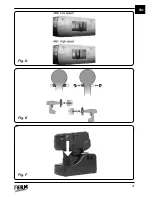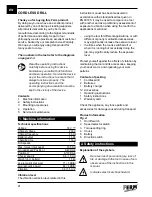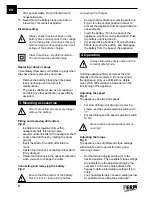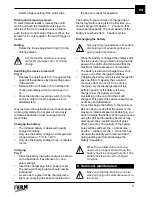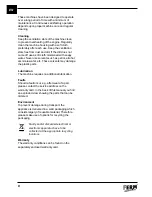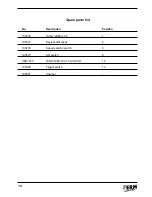
EN
6
of as special waste. Do not discard it with
household waste.
15. Never throw the battery block onto a fire or
into water. This will risk explosion!
Electrical safety
Always check that the voltage on the
battery block corresponds to the voltage
on the rating plate. Also check that your
mains voltage corresponds to the input
voltage of the battery charger.
Class II machine – Double insulation –
You don’t need any earthed plug.
Replacing cables or plugs
Immediately throw away old cables or plugs when
they have been replaced by new ones.
Remove the battery block when the power
•
tool is not being used and prior to
maintenance.
The tool is suitable for use as a screwdriver
•
and drill. Any other application is specifically
excluded.
3. Mounting accessories
Prior to mounting an accessory always
remove the battery.
Fitting and removing drill cutters
Fig. B
In addition to screwdriver bits with a
•
hexagonal shaft, this tool can also
accommodate drill bits with a hexagonal shaft.
Loosen the drill chuck by rotating the hand-
•
grip (A).
Insert the shaft of the drill cutter into the
•
chuck.
Tighten the drill chuck so that the drill cutter is
•
firmly clamped.
Rotate the drill chuck in the opposite direction
•
when you wish to change the cutter.
Connecting and removing the battery
Fig. C
Ensure that the exterior of the battery
block or tool is clean and dry before
connecting the charger.
Ensure that the direction reversing switch (6,
•
Fig. A) is in the central position in order to
prevent the appliance from being switched on
unexpectedly.
Insert the battery (5) into the base of the
•
appliance, as shown on the illustration. Push
the battery until it latches in.
Press the locking buttons (10) on both sides
•
before removing the battery, and disengage
the battery from the base of the appliance.
4. Operation
Always follow the safety notes and the
relevant safety code.
Hold the appliance firmly and press the drill
steadily onto the workpiece. Do not overload
the appliance. Only use drills with no visible
wear. Worn drills will have a bad effect on the
functioning of the appliance.
Adjusting the speed
Fig. D
The appliance has two drill speeds.
For slow drilling or for driving or removing
•
screws, set the speed selection switch (2) to ‘
’.
For fast drilling set the speed selection switch
•
to ‘ ’.
Never switch over when the motor is
running!
Adjusting the torque
Fig. E
The appliance has 20 different torque settings
with which to set the power for driving and
removing screws.
Set the torque adjustment ring (3) to the
•
desired position. The available torque settings
are indicated on the adjustment ring by the
numbers 1 to 8 and by dots between the
figures to define intermediate settings (16 in
total).
You should preferably choose a setting as low
•
as possible when using the screwdriver.



